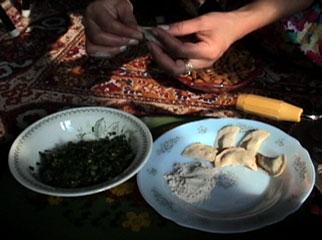
|
Kabul: Reconstructions explores the multiple manifestations, meanings and resonances of the idea of reconstruction – as both process and metaphor – in the city of Kabul in the last days of 2002. In the Afghan bureaucratic arena, dominated by the jargon and worldview of international NGOs, reconstruction refers to large-scale social and economic development projects meant to build or alter the infrastructure of the country’s administration, production, and regulation. On the local level, meanwhile, reconstruction seems to translate into the literal renovations and new constructions undertaken by individuals as they seek to rebuild the physical city. Finally, for those of us outside Afghanistan, reconstruction comes to mean the process by which we piece together an image of this place and these people from the scraps of information gathered between the lines of mass media transmissions, the memories preserved in expatriate family stories, traditions & recipes, or personal communications from friends and family on the inside. | |
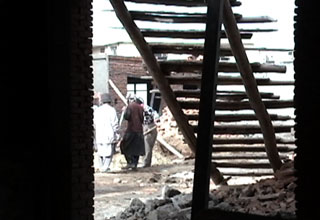
|
The video is made up of six different kinds of footage, all shot in Kabul in December 2002 and assembled into a loose database form: road footage from a drive through Kabul’s many neighborhoods and suburbs; scenes from construction sites around the city; carpenters from Nuristan building and hand-carving an ornamental cabinet to furnish my parents’ new Kabul home; dusk falling at the Microrayan, a housing project built – but never finished – during the Soviet era; the women of my family making aushak, a traditional Afghan dish; and a performance where in the absence of my father, who is my own primary link to the country, I decided to dress up in his clothes. | |
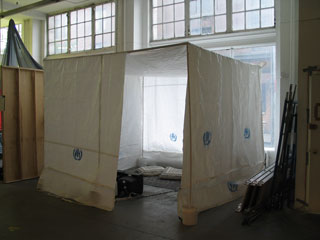
|
Kabul: Reconstructions was originally produced for a site-specific exhibition at Exit Art in New York, where it was installed on three monitors housed inside a replica of a UNHCR refugee tent. A carpet and pillows were arranged in the tent so that people could sit and watch the video, and one day a week I interacted with visitors to the tent by serving them tea and World Food Programme biscuits while offering to answer their questions about the project and about the current events in and history of Afghanistan. As part of the project, I also invited a group of Afghan-Americans and Afghans (including young journalism students from the AINA Afghan Media Center in Kabul) to revise and update my view of reconstruction by posting video, audio, images, text and links to a communal weblog, which can still be accessed online at www.kabul-reconstructions.net. | |
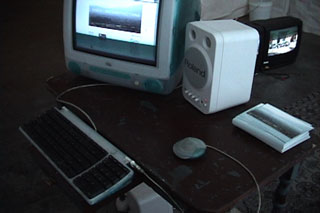
|
After the Exit Art exhibition closed, the website was adapted to add a section called Ask A Question, where viewers could submit their questions about Kabul's reconstruction through an online form. Once a question was submitted, I would use familial diasporic networks to transmit it to Kabul and bring back an answer, thereby enabling the general public to access these alternative sources of information about the Afghan situation that generally remain in the private realm. For over a year, I also maintained a monitor of Western media coverage of the reconstruction in the Follow the Information section of the site, so that visitors could contrast the very different kinds of information provided by these different sources. When the Ask section first went live, I sent an announcement to several listservs, which was forwarded across the Internet, and while the number of questions asked was relatively small (although they were surprisingly interesting and difficult to answer) the website received 50,000 hits in the next 12 months. It was also quickly indexed in major search engines, which meant that accidental viewers (people searching the terms "kabul" or "reconstruction," for example) frequently find their way to the site. While I can no longer spare the time to update the site constantly, I do try every few months to answer the questions that continue to accumulate. |
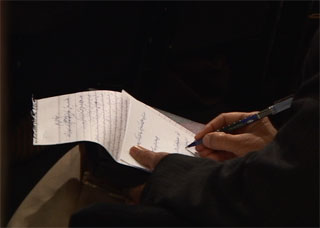
|
When I returned to Kabul in the winter of 2003-04, the construction sites I had filmed the year before were now busy shops and restaurants, and the city's inhabitants were collectively mulling over the more abstract question of how to rebuild their fragmented democracy, as their new constitution was being debated both in the official arena of the constitutional assembly and over cups of tea and radio waves all over town. Kabul: Constitutions, the second installment of the Kabul project, includes a direct sequel to the three-channel video produced in Kabul: Reconstructions, shot by revisiting the sites, people and streets filmed the year before, and a new video shot in the assembly itself, which became a new interactive installation prototyped during a residency at Eyebeam Atelier. A web version of the interactive installation was constructed at kabul-reconstructions.net/constitutions in winter 2007/8. In this online version, the installation's map interface is accompanied by contextual information and a public dialogue forum. Media coverage of the constitutional assembly is currently archived in the Information section of the main kabul-reconstructions.net site. | |
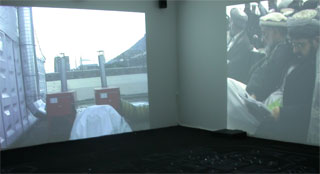
|
The interactive three-channel installation version of Kabul: Constitutions places viewers within the specific moment of the Constitutional Loya Jirga, the national tribal council and constitutional assembly convened under the glare of the media spotlight in a high-tech tent complex on the campus of Kabul Polytechnic University at the beginning of 2004. The installation investigates the question of how our imaginaries of the architectures of democracy overlap with the real spaces where the structures of the state are materially and politically invested and contested by mapping events and issues from the Jirga onto a spatial interface that viewers must navigate to make sense of the video. | |
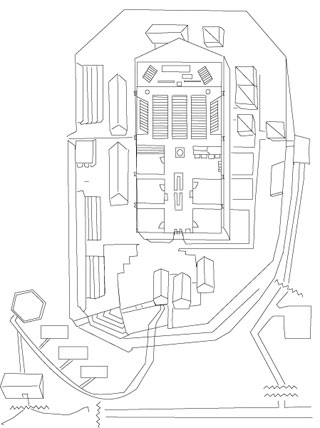
|
That interface is an architectural schematic of the Jirga’s tent complex (including plenary tent, auxiliary tents, security structures, and repurposed campus buildings), stenciled in white onto a 12’ x 17’ sheet of grey industrial carpet (similar to that used to carpet the plenary tent), which has been embedded with sensors at points in the map corresponding to places I filmed within the complex (in the prototype proximity sensors protruding from the map, and now pressure sensors under the carpet). When viewers walk into the installation, they have a blank wall behind them, the map stretching out on the floor in front of them in birds-eye-view, a projection of the auxiliary and peripheral spaces on the left side of the complex on the left wall, a projection of the plenary tent (where the official narrative of the assembly unfolded) on the center wall, and a projection of the auxiliary and peripheral spaces on the right side of the complex on the right wall. Each projection runs in a loop, beginning with 1-5 minute videos from spaces at the top of the map and working its way down to the bottom of the map, then starting from the top again; in the center projection, all the videos take place in the plenary tent, but are divided based on the assigned seating or semi-fixed positions of different actors in the constitutional process (delegates, diplomats, government observers, guests, press, ushers, tea servers and so on). Each projection also has stereo sound that plays through speakers mounted at the corners of wall and ceiling. | |
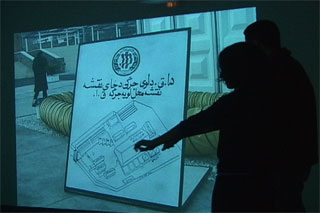 |
As a viewer walks through the installation and on the carpet-map, she triggers sensors that are serially controlling the DVD players linked to the three projections, which then causes the relevant projection to jump to the video of the particular part of the space that she is passing through. The DVDs contains 2.5 total hours of footage, subtitled in English with speakers identified whenever possible, and have a linear running time of about 1.5 hours. During the run of the Eyebeam exhibition of Kabul: Constitutions, I gave weekly "guided tours" of the exhibition – sometimes with co-hosts who attended the Jirga in other roles – during which I encouraged visitors to interact with the video through the spatial interface, further explained the context of events and encounters in the footage, and initiated dialogues about the issues raised by the installation and by the assembly. A PDF 'guidebook' that contains much of the same information can now be downloaded from the web version of the project. | |
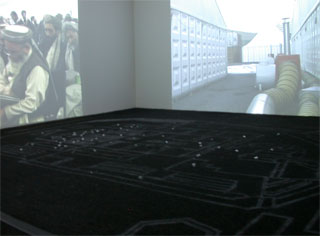
|
The mapped database form of Kabul: Constitutions poses the question: what kind of representation is more faithful to the nature of a political process like a constitutional assembly, especially in an essentially failed state? As an artist who has had unusually privileged access to the “back rooms” of Afghanistan’s post-war politics, I always feel that something is missing from the traditional documentaries that are produced around events like these. In constructing their linear sense, applying the omniscience of hindsight to show you only what proved to be important when the final day was done, those films lose that vital confusion, contradiction and immediacy which mark the actual experience of democracy in construction. It’s really a three-ring circus, gloriously messy, often opaque. There are always simultaneous but disjunctive narratives unfolding in the public and private spaces of the assembly. There are speeches that repeat themselves and each other. There are cameras everywhere, an inflection profoundly felt and rarely seen in media accounts. There are false starts and false promises and long periods of waiting and speculation. It’s history in the present tense, not passing into the past so quickly for those of us not only observing but also invested; the constitution is and will be lived by the people deciding it and the people watching every move on Afghan TV. | |
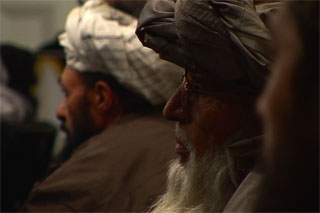
|
I wanted to use the database and interface to preserve all of these elements – in a way, shifting the focus of the work to everything that would be B-roll ("local color") in a traditional documentary – so that the viewer, instead of being fed an understanding of what happened at the assembly, might have the chance to feel what it was like to be there. |
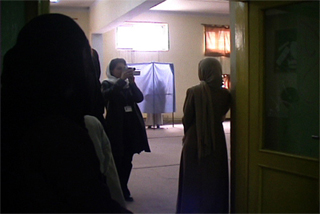
|
Part 3 of the Kabul Trilogy, Kabul: Selections, investigates the politics of choice during Afghanistan’s first popular election, the presidential election of 2004, through video footage of election preparations, voters at the polls, and interviews in the wake of initial reports. The moment of the election and the choices made by politicians and voters in that moment are explored both in the immediacy of election day and also from the retrospective perspective that marks that day as the turning point when trust in the government began to erode and the process of post-war reconstruction commenced a decisive downward spiral. | |
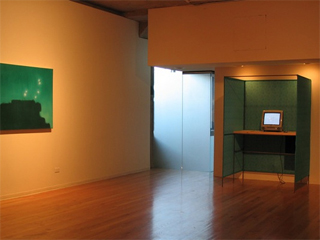
|
The interactive installation prototype of Kabul: Selections premiered in fall 2006 as part of the Underfire exhibition in Chicago. The online version of the offline prototype launched in winter 2007/8. |